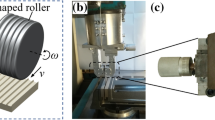Abstract
Increasing the traction coefficient of a traction drive system is a key factor in obtaining a smaller, lighter unit and also greater torque capacity. This study focused on the microtexture of the rolling elements, and effect of microtexture was examined with the aim of improving the traction coefficient in the viscous region. Three textures—dimple, transverse, and longitudinal—were examined using a 4-roller tester that enabled tests to be conducted under high pressure and high rolling speed. As a result, it was found that the longitudinal surface texture is the best for improving the traction coefficient. The results obtained with EHL analysis showed that only the surface texture with longitudinal grooves increased the traction coefficient, just as in the tests conducted with the 4-roller tester. The longitudinal surface texture was optimized using the 4-roller tester. The test results made it clear that the groove depth, groove pitch, and also the radius of curvature of the convex portion of the rolling elements are important parameters of the longitudinal grooves for improving the traction coefficient while assuring high durability at the same time. An attempt was then made to increase the traction coefficient of an actual CVT variator by applying the optimized longitudinally grooved microtexture to the traction surfaces. The test results show that the traction coefficient can be increased without sacrificing durability by optimizing the surface microtexture.






















Similar content being viewed by others
Abbreviations
- a :
-
Semiminor axis of Hertzian contact ellipse
- b :
-
Semimajor axis of Hertzian contact ellipse
- E′:
-
Effective Young’s modulus
- G :
-
Limiting elastic shear modulus
- h :
-
Local film thickness
- h a :
-
Average film thickness
- p :
-
Hydrodynamic pressure
- p c :
-
Asperity contact pressure
- P h :
-
Maximum Hertzian pressure
- R x :
-
Effective radius in x–z plane
- R y :
-
Effective radius in y–z plane
- T :
-
Temperature
- t :
-
Time
- U :
-
(u 1+u 2)/2
- u 1, u 2 :
-
Velocities of surface 1 and surface 2
- V :
-
Surface deformation
- α:
-
Pressure-viscosity coefficient
- δ1, δ2 :
-
Roughness heights for surfaces 1 and 2
- η:
-
Viscosity
- ηo :
-
Viscosity under ambient condition
- ρ:
-
Density of lubricant
- ρo :
-
Density of lubricant under ambient condition
- σ:
-
Composite RMS roughness
- τ:
-
Shear stress
- τL :
-
Limiting shear stress
- x :
-
Rolling direction
References
Evans C.R., Johnson K.L.: Regimes of traction in elastohydrodynamic lubrication. Proc. Inst. Mech. Eng. 200,C5 313–324 (1986)
Kamei, D., Zhou, H., Suzuki, K., Konno, K., Takami, S., Kubo, M., Miyamoto, A.: Computational chemistry study on the dynamics of lubricant molecule under shear conditions. Tribology Int. 36, 297 (2003)
Nanbu, T., Chiba, N., Kano, M., Ushijima, K.: The effect of surface texture on traction performance in a traction drive. JSAE Review. 24, 135–140 (2003)
Nanbu, T., Chiba, N., Kano, M., Ushijima, K.: The effect of surface roughness on elastohydrodynamic traction (1). Lubrication Science. 17-4, 281 (2005)
Ushijima, K., Nanbu, T., Chiba, N., Kano, M., Aoyama, S.: The effect of surface roughness on elastohydrodynamic traction (2). Lubrication Science. 17-4, 403 (2005)
Hu, Y.Z., Zhu, D.: A full numerical solution to the mixed lubrication in point contacts. Tribol. Trans. 122, 1–9 (2000)
Zhu, D., Hu, Y.Z.: A Computer program for the prediction of EHL and mixed lubrication characteristics, friction, subsurface stresses and flash temperatures based on measured 3-D surface roughness. Tribol. Trans. 44, 383–390 (2001)
Zhu, D., Hu, Y.Z.: Effects of rough surface topography and orientation on the characteristics of EHD and mixed lubrication in both circular and elliptical contacts. Tribol. Trans. 44, 391–398 (2001)
Zhu, D.: On some aspects of numerical solutions of thin-film and mixed elastohydrodynamic lubrication. Proc. Inst. Mech. Eng. 221, Part J, 561–579 (2007)
Bair, S., Winer, W.O.: A rheological model for elastohydrodynamic contacts based on primary laboratory data. ASME Journal of Lubrication Technology. 101, 258–265 (1979)
Zhu, D., Cheng, H.S.: An analysis and computational procedure for EHL film thickness, friction, and flash temperature in line and point contacts. Tribol. Trans. 32, 364–370 (1989)
Patir, N., Cheng, H.S.: An average flow model for determining effect of three-dimensional roughness on partial hydrodynamic lubrication. ASME J. Lub. Technol. 100, 12 (1978)
Hamrock B.J.: Fundamentals of fluid film lubrication, p. 472. McGraw-Hill, Inc., New York (1994)
Watanabe, J., Oshidari, T., Yoshitani, K.: A study of traction characteristics of an automotive toroidal CVT: traction characteristics of an actual unit (3rd Report), proceedings of 2003 annual conference of the Japan society of mechanical engineers, Tokushima, 23 (in Japanese)
Acknowledgments
The authors would like to thank Professor Tsunamitsu Nakahara and Professor Keiji Kyougoku of the Tokyo Institute of Technology for their helpful guidance in the course of conducting this study.
Author information
Authors and Affiliations
Corresponding author
Rights and permissions
About this article
Cite this article
Nanbu, T., Yasuda, Y., Ushijima, K. et al. Increase of Traction Coefficient due to Surface Microtexture. Tribol Lett 29, 105–118 (2008). https://doi.org/10.1007/s11249-007-9287-9
Received:
Accepted:
Published:
Issue Date:
DOI: https://doi.org/10.1007/s11249-007-9287-9




